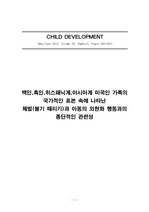백인,흑인,히스패닉계,아시아계 미국인 가족의 국가적인 표본 속에 나타난 체벌(볼기 때리기)과 아동의 외현화 행동과의
종단적인 관련성
Elizabeth T. Gershoff / Jennifer E. Lansford / Holly R. Sexton
/ Pamela Davis-Kean and Arnold J. Sameroff
본 연구는 문화적인 규범이론에 따라 예상되는 것처럼, 체벌의 평균사용빈도 차이를 통제하면, 어머니의 체벌 사용과 아이들의 외현화 행동사이와의 관계가 가족의 인종/민족성에 따라 조정이 되는지를 종단적으로 조사한 것이다. 5세부터 8세 까지의 교차 지연 경로 모델을 검증하기 위해 백인, 흑인, 히스패닉계. 아시아계 미국인 가족을 대표하는 국가적인 표본이 사용되었다(n=11,044). 체벌의 빈도에 있어서 인종/민족적 차이점이 관찰된 반면에, 시간이 흐름에 다른 체벌과 외현화와의 관련성 속에는 어떠한 차이점도 발견되지 않았다. 모든 인종/민족적 집단 속에서 초기 아동의 외현화는 시간이 흐름에 따라 더 많은 체벌을 이끌어내고, 초기의 체벌은 아이들의 외현화의 증가를 예상합니다.
<중 략>
현재의 연구는 몇 가지의 방식에 제한되어있다. 첫째로, 가족들 사이에 “체벌”에 있어서 무엇을 고려해야하는가에 대한 가변성이 있기 쉽다. 체벌이 어떻게 전달되는지(손에 의해서 또는 다른 물건들에 의해서), 그리고 언제 전달이 되는지(규칙적이거나 의도적으로 또는 돌발적으로나 감정적으로)는 가족들에 따라 다르다. 두 번째로, 규모면에 있어서 효과가 작고, 체벌과 아이들의 외현화 행동과 관련하여 오직 변화의 작은 부분만을 설명하고 있다. 그러나, 역학적인 관점으로부터, 작지만 중요한 영향은 우리가 본 연구에서 표본법을 사용했던 것처럼 전체로서의 인구로 추론했을 때, 커다란 영향을 줄 수 있다. 세 번째로, 위에서 간략히 설명된 선행연구와 더불어, 본 연구는 체벌의 절정의 나이(3세)를 넘어선, 유년기 중반기의 아동에 중점을 두었다. 미취학 아동의 표본과 함께 이러한 결과들이 반복검증 된다면, 이는 후속 연구를 결정 하는데 중요한 역할을 할 것이다. 마지막으로, 본 연구는 직접적으로 문화적 규범성을 측정하지 않았다; 조사자들에게 집단 규범과 양육 행동 사이의 관계를 명확하게 이해시키도록 하기 위하여.
· Dalaker, J. (1999). Poverty in the United States: 1998. U.S. Census Bureau, Current Population Reports (P60-270). Washington, DC: U.S. Government Printing Office. Retrieved from http://www.census.gov/hhes/www/poverty/prevcps/p60-207.pdf
· Deater-Deckard, K., & Dodge, K. A. (1997). Externalizing behavior problems and discipline revisited: Nonlinear effects and variation by culture, context, and gender. Psychological Inquiry, 8, 161?-175.
· Deater-Deckard, K., Dodge, K. A., Bates, J. E., & Pettit, G. S. (1996). Physical punishment among African American and European American mothers: Links to children’`s externalizing behaviors. Developmental Psychology, 32, 1065?-1072.
· Durrant, J. E. (2008). Physical punishment, culture and rights: Current issues for professionals. Journal of Developmental and Behavioral Pediatrics, 29, 55?-66.
· Flynn, C. P. (1998). To spank or not to spank: The effect of situation and age of child on support for corporal punishment. Journal of Family Violence, 13, 21?-37.
· Gershoff, E. T. (2002). Corporal punishment by parents and associated child behaviors and experiences: A meta-analytic and theoretical review. Psychological Bulletin, 128, 539?-579.
· Gresham, F. M., & Elliott, S. N. (1990). Social Skills Rating System manual. Circle Pines, MN: American Guidance Service.
· Grogan-Kaylor, A. (2005). Corporal punishment and the growth trajectory of children’`s antisocial behavior. Child Maltreatment, 10, 283?-292.
· Grogan-Kaylor, A., & Otis, M. D. (2007). The predictors of parental use of corporal punishment. Family Relations, 56, 80?-91.
· Gunnoe, M. L., & Mariner, C. L. (1997). Toward a developmental-contextual model of the effects of parental spanking on children’`s aggression. Archives of Pediatric and Adolescent Medicine, 151, 768?-775.
· Holden, G. W., Coleman, S. D., & Schmidt, K. L. (1995). Why 3-year-old children get spanked: Parent and child determinants in a sample of college-educated mothers. Merrill-Palmer Quarterly, 41, 431?-452.
· Lansford, J. E., Deater-Deckard, K., Dodge, K. A., Bates, J.E., & Pettit, G. S. (2004). Ethnic differences in the link between physical discipline and later adolescent externalizing behaviors. Journal of Child Psychology and Psychiatry, 45, 801?-812.
· Lau, A. S., Litrownik, A. J., Newton, R. R., Black, M. M.,& Everson, M. D. (2006). Factors affecting the link between physical discipline and child externalizing problems in Black and White families. Journal of Community Psychology, 34, 89?-103.
· McLeod, J. D., Kruttschnitt, C., & Dornfield, M. (1994). Does parenting explain the effects of structural conditions on children’`s antisocial behavior? A comparison of Blacks and Whites. Social Forces, 73, 575?-604.
· Muthe´n, L. K., & Muthe´n, B. O. (2010). Mplus user’`s guide (6th ed.) Los Angeles: Muthe´n & Muthe´n. Pardini, D. A., Fite, P. J., & Burke, J. D. (2008). Bidirectional associations between parenting practices and conduct problems in boys from childhood to adolescence: The moderating effect of age and African?-American ethnicity. Journal of Abnormal Child Psychology, 36, 647?-662.
· Patterson, G. R. (1982). Coercive family process. Eugene, OR: Castalia. Pollack, J., Atkins-Burnett, S., Rock, D., & Weiss, M. (2005). Early Childhood Longitudinal Study, Kindergarten Class of 1998?-99 (ECLS?-K), Psychometric report for the third grade (NCES 2005?-062). Washington, DC: U.S. Department of Education, National Center for Education
· Statistics.
· Rathbun, A., & West, J. (2004). From kindergarten through third grade: Children’`s beginning school experiences (NCES 2004-007). U.S. Department of Education, National Center
· for Education Statistics. Washington, D.C.: Government Printing Office.
· Sameroff, A. J. (2009). The transactional model. In A. J.Sameroff (Ed.), The transactional model of development: How children and contexts shape each other (pp. 3?-21).
· Washington, DC: American Psychological Association. Satorra, A. (2000). Scaled and adjusted restricted tests in multi-sample analysis of moment structures. In D. D.
· H. Heijmans, D. S. G. Pollock, & A. Satorra (Eds.), Innovations in multivariate statistical analysis: A festschrift for Heinz Neudecker (pp. 233?-247). Dordrecht, Netherlands:
· Kluwer Academic Publishers.
· Slade, E. P., & Wissow, L. S. (2004). Spanking in early childhood and later behavior problems: A prospective study of infants and young toddlers. Pediatrics, 113, 1321?-1330.
· Tourangeau, K., Brick, M., Byrne, L., Le??, T., Nord, C.,West, J., et al. (2004). Early Childhood Longitudinal Study, Kindergarten Class of 1998?-99 (ECLS?-K) third grade methodology report. (NCES 2005-018). U.S. Department of Education. Washington, DC: National Center for Education Statistics.
· West, J., Denton, K., & Reaney, L. (2000). The kindergarten year findings from the Early Childhood Longitudinal Study, kindergarten class of 1998-99. Washington, DC: National Center for Education Statistics.

